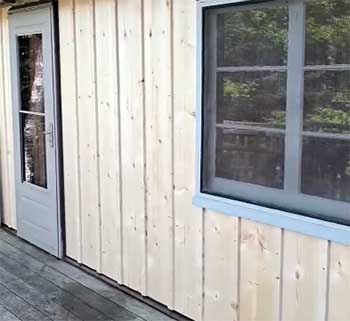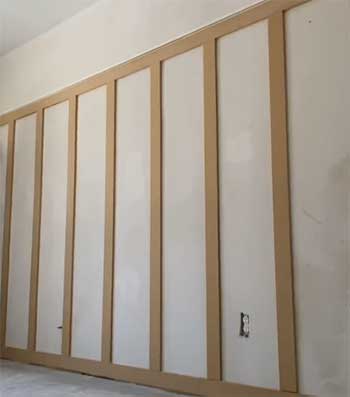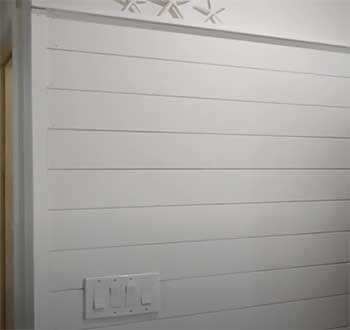I’ve always been drawn to the charm of textured walls, and lately, I’ve been wrestling with a choice: board and batten or shiplap? Both are stunning, but they each bring something unique to a space.
In this article, I’ll break down their features, weigh their pros and cons, and help you decide which suits your home best. Whether you’re renovating or just dreaming up a new look, let’s explore these two classic wall treatments together and find the perfect fit for your style.
A Brief Comparison Table
| Feature | Board and Batten | Shiplap |
| Appearance | Vertical boards with battens, bold and structured | Horizontal planks with subtle gaps, rustic and soft |
| Installation | Moderate; requires precise measurements | Easier; planks align with minimal fuss |
| Cost | $3–$10 per sq. ft. (materials and labor) | $2–$7 per sq. ft. (materials and labor) |
| Durability | High; sturdy boards resist wear | Moderate; thinner planks may dent |
| Maintenance | Easy; wipe down, repaint as needed | Easy; clean gaps, repaint if desired |
| Versatility | Formal, modern, or rustic; highly adaptable | Rustic or coastal; less formal |
| Skill Level | Intermediate; needs carpentry skills | Beginner-friendly; simpler to install |
My Journey Into Wall Treatments

When I first started planning my home’s makeover, I pictured walls that told a story—something beyond flat paint.
I stumbled across board and batten and shiplap while scrolling through home design inspiration, and both caught my eye instantly.
Their textures, their character, their ability to transform a room—it was love at first sight.
But choosing between them?
That’s where things got tricky. I wanted something that felt personal, practical, and timeless, so I set out to understand what makes each one special.
Board and batten has this architectural gravitas. It’s bold, with vertical boards and thin strips (battens) covering the seams, creating a grid-like pattern. Shiplap, on the other hand, feels softer, with its horizontal planks and subtle gaps that give off a cozy, lived-in vibe.
Both have history, both have charm, but they serve different purposes. Let’s unpack what they’re all about and how they stack up.
What Is Board and Batten?
Board and batten started as a practical exterior siding technique centuries ago, used on barns and homes to keep out the elements. The “board” is a wide piece of wood, and the “batten” is a narrower strip that covers the gaps between boards.
Today, it’s a go-to interior wall treatment, often made from wood, MDF, or even PVC for budget-friendly projects.
I love how board and batten adds structure to a room. The vertical lines draw the eye upward, making ceilings feel taller—a godsend for my cozy living room.
You can customize the spacing, board width, and batten size to create anything from a modern, clean look to a rustic, farmhouse feel. It’s like the chameleon of wall treatments, adapting to whatever vibe you’re going for.
Pros of Board and Batten
Let’s talk about why board and batten might steal your heart. For me, its biggest draw is the drama it brings. The vertical lines and bold battens create a sense of order and sophistication. Here’s what I found makes it stand out:

- Architectural Impact: The grid-like pattern adds depth and structure, perfect for formal spaces like dining rooms or entryways. It’s like giving your walls a tailored suit.
- Versatility: You can paint it crisp white for a modern look, go dark for moody elegance, or leave it natural for rustic charm. I’ve seen it work in minimalist lofts and cozy farmhouses alike.
- Durability: The thicker boards and battens hold up well against bumps and scratches. In my house, where kids and pets are a constant, this is a huge plus.
- Ceiling Height Illusion: The vertical lines trick the eye into seeing taller ceilings, which is great for smaller rooms. My 8-foot ceilings suddenly felt grander.
- Customizable: Adjust board width, batten spacing, or even add curves for a softer look. I played with wider battens in my office for a bolder statement.
Cons of Board and Batten
But it’s not all sunshine and rainbows. Board and batten has its quirks, and I ran into a few challenges when considering it:
- Installation Complexity: It’s not a beginner’s project. Measuring and cutting boards to fit perfectly, then nailing battens precisely, takes skill. I tried a small DIY section and ended up with wonky gaps—lesson learned.
- Cost: Materials and labor can add up, especially for custom wood or large spaces. My contractor quoted $5–$10 per square foot, which made me pause.
- Dust Traps: Those battens can collect dust, especially in intricate designs. I noticed this in a friend’s home with detailed batten work—cleaning was a chore.
- Less Cozy: The structured look can feel too formal for some spaces. My bedroom needed a softer vibe, and board and batten felt a bit stiff.
- Time-Intensive: Whether DIY or professional, installation takes longer than shiplap due to the precision required. My weekend project stretched into a week.
What Is Shiplap?
Shiplap, by contrast, has a more laid-back origin story.
It was originally used in shipbuilding, where overlapping planks created watertight seals.
Fast-forward to today, and it’s the darling of rustic and coastal interiors, thanks to its horizontal lines and slightly imperfect charm.
Authentic shiplap has a rabbet (a notched edge) that lets planks overlap snugly, but modern versions often mimic the look with tongue-and-groove or simple gaps.
When I first saw shiplap in a friend’s beachy cottage, I was hooked. The soft lines and subtle texture felt inviting, like the walls were whispering, “Relax here.” It’s less formal than board and batten, with a warmth that suits casual spaces like kitchens or bedrooms.
Pros of Shiplap
Shiplap, on the other hand, has a different kind of magic. It’s like the friendly, approachable cousin of board and batten. Here’s why I fell for it:

- Rustic Charm: The horizontal lines and small gaps give off a relaxed, lived-in feel. It’s perfect for creating that cozy, “I just moved into a farmhouse” vibe.
- Easier Installation: Shiplap planks align more forgivingly than board and batten. I watched a friend install it in her kitchen over a weekend, and it looked pro-level with minimal effort.
- Budget-Friendly: At $2–$7 per square foot, it’s often cheaper than board and batten, especially if you use MDF or pre-primed planks. My wallet appreciated this.
- Versatile Finishes: Paint it, stain it, or leave it raw for that weathered look. I saw a shiplap wall in soft gray that made a nursery feel serene.
- Low Maintenance: The smooth planks are easy to wipe down, and the gaps are small enough to avoid major dust buildup. My friend’s shiplap kitchen still looks pristine.
Cons of Shiplap
Shiplap isn’t perfect, though. As much as I adore its charm, I hit a few snags when considering it for my home:
- Less Durable: Shiplap planks are often thinner, making them prone to dents or scratches. My dog’s enthusiastic tail-wagging could do some damage.
- Limited Style Range: Shiplap leans heavily rustic or coastal. It didn’t quite fit the sleek, modern vibe I wanted for my office.
- Moisture Sensitivity: In humid areas, wood shiplap can warp if not properly sealed. My bathroom reno plans hit a snag when I realized this.
- Trend Concerns: Shiplap’s popularity surged thanks to home makeover shows, making me wonder if it’s a passing fad. I didn’t want my walls to feel dated in a decade.
- Gap Cleaning: Those tiny gaps between planks can trap dust or crumbs. In my kitchen, where spills are a daily event, this was a concern.
Key Differences Between Board and Batten And Shiplap
- Aesthetic and Style Differences
Walking through homes with board and batten versus shiplap feels like stepping into different worlds. Board and batten has a structured, almost regal quality.
In my dining room, I tested a sample wall with board and batten in deep navy, and it instantly felt like a space for grand dinner parties. The vertical lines add height and formality, making it ideal for modern, traditional, or even industrial spaces.
Shiplap, by contrast, is the cozy sweater of wall treatments. I visited a friend’s beach house with white shiplap walls, and the horizontal lines made the room feel wider and more relaxed.
It’s perfect for casual spaces like living rooms, bedrooms, or even a sunroom. But in my sleek office, shiplap felt out of place—like it was trying too hard to be chill.
- Installation and Practicality
When I started planning my project, installation was a big factor. Board and batten intimidated me a bit. The process involves cutting wide boards to fit your wall, nailing them in place, and then adding battens to cover the seams.
If your walls aren’t perfectly straight (mine aren’t), you’ll need shims or extra sanding to avoid gaps. I watched tutorials and realized I’d need a good saw, a level, and a lot of patience. Hiring a pro was tempting but pricey.
Shiplap, on the other hand, felt more approachable. The planks are lighter, and the rabbet or tongue-and-groove design means they slot together easily. I helped a friend install shiplap in her laundry room, and we finished in a day with just a nail gun and some basic measuring.
Even with my limited DIY skills, it felt doable. For renters or DIY newbies, shiplap’s simplicity is a big win.
- Cost Breakdown
Money matters, and I had to crunch the numbers. Board and batten’s cost depends on materials—real wood like pine or cedar is pricier ($5–$10 per square foot with labor), while MDF can drop to $3–$5. Custom designs or intricate patterns push the price higher.
My 150-square-foot living room would’ve cost around $750–$1,500, which gave me sticker shock.
Shiplap is generally kinder to the budget. Pre-primed MDF planks run $2–$4 per square foot, and even real wood options like pine stay under $7 with labor. For the same living room, I was looking at $300–$1,000. If you’re DIY-ing, shiplap’s lower material costs and simpler install can save you even more.
- Durability and Maintenance
I’ve got a lively household, so durability is non-negotiable. Board and batten’s thicker boards and battens feel like they could withstand a toddler tornado. I tested a sample board by bumping it with a chair—no dents, no drama.
Cleaning is straightforward: a quick wipe-down or touch-up paint keeps it fresh. The only hassle is dusting the batten edges, especially in detailed designs.
Shiplap’s thinner planks worried me a bit. A friend’s shiplap wall got a dent from a rogue toy, and it wasn’t a quick fix. Maintenance is easy enough—wipe the planks, vacuum the gaps—but those gaps can collect crumbs in a kitchen or mudroom.
Sealing or painting helps with durability, but it’s not as bulletproof as board and batten.
- Versatility in Design
One thing I love about both treatments is their flexibility, but they shine in different ways. Board and batten feels like a blank canvas. I saw it painted black in a modern loft, white in a traditional dining room, and stained wood in a rustic cabin—all stunning.
You can play with batten spacing or add curves for a softer look. It’s like a tailored outfit that works for any occasion.
Shiplap’s versatility leans toward casual styles. White or light gray shiplap screams coastal or farmhouse, while stained wood gives off a barn-like vibe. I tried picturing it in my modern office, but it felt too relaxed, like it belonged in a beach cottage. If your style is formal or sleek, shiplap might not fit as well.
- Timeless Vs. Trendy

I’m always paranoid about my home looking dated, so I thought hard about longevity.
Board and batten has been around for centuries, from colonial homes to modern builds.
Its clean lines and architectural roots make it feel timeless, like a classic white shirt.
I felt confident it wouldn’t go out of style anytime soon.
Shiplap, though, gave me pause. Its popularity exploded in the 2010s, thanks to home renovation shows.
While it has historical roots, its current fame feels tied to trends. I worried that in a decade, shiplap might scream “2020s” the way avocado green screams “1970s.” Still, its simplicity keeps it from feeling too faddish.
Choosing For Your Space
Picking between board and batten and shiplap comes down to your space and lifestyle. I ended up choosing board and batten for my living room because I wanted that structured, elegant look to balance my eclectic furniture.
The vertical lines made the room feel taller, and the durability was perfect for my chaotic household. But for my guest bedroom, I’m leaning toward shiplap. Its cozy, horizontal lines will make the small space feel wider and more inviting.
Think about your room’s vibe. Want formal or modern? Board and batten’s your guy. Craving cozy or rustic?
Shiplap’s got you covered. Consider your DIY skills, budget, and maintenance tolerance too. If you’re not handy, shiplap’s easier install might sway you. If durability’s key, board and batten’s sturdiness is hard to beat.
Frequently Asked Questions (FAQ)
Neither is objectively better—it depends on your style and needs. Board and batten suits formal or modern spaces with its bold, vertical look and durability. Shiplap’s rustic, horizontal charm is easier to install and budget-friendly but less versatile.
It’s pricier ($3–$10 per square foot) and harder to install, requiring precise measurements and carpentry skills. The battens can also collect dust, making cleaning trickier.
Board and batten is timeless. Its architectural roots and versatility across styles make it a classic choice that won’t date quickly.
Textured wall panels, like fluted or 3D geometric designs, are gaining traction for their modern, sculptural look, offering a fresh alternative to shiplap’s rustic vibe.
Wrapping It Up
You’re probably feeling the same way I did—torn between two gorgeous wall treatments, each with its own personality. Board and batten brings bold structure and timeless elegance, perfect if you want a room that feels polished and sturdy.
Shiplap offers cozy, rustic charm with easier installation and a lower price tag, ideal for casual spaces. Whichever you choose, you’re adding character to your home that’ll make it uniquely yours.
So, go grab your paintbrush or call your contractor, and let’s make those walls sing!
